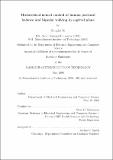| dc.contributor.advisor | Steve G. Massaquoi. | en_US |
| dc.contributor.author | Jo, Sungho, 1974- | en_US |
| dc.contributor.other | Massachusetts Institute of Technology. Dept. of Electrical Engineering and Computer Science. | en_US |
| dc.date.accessioned | 2007-07-17T19:41:20Z | |
| dc.date.available | 2007-07-17T19:41:20Z | |
| dc.date.copyright | 2006 | en_US |
| dc.date.issued | 2006 | en_US |
| dc.identifier.uri | http://hdl.handle.net/1721.1/37854 | |
| dc.description | Thesis (Ph. D.)--Massachusetts Institute of Technology, Dept. of Electrical Engineering and Computer Science, 2006. | en_US |
| dc.description | This electronic version was submitted by the student author. The certified thesis is available in the Institute Archives and Special Collections. | en_US |
| dc.description | Includes bibliographical references (p. 177-192). | en_US |
| dc.description.abstract | The cerebrocerebellar system has been known to be a central part in human motion control and execution. However, engineering descriptions of the system, especially in relation to lower body motion, have been very limited. This thesis proposes an integrated hierarchical neural model of sagittal planar human postural balance and biped walking to 1) investigate an explicit mechanism of the cerebrocerebellar and other related neural systems, 2) explain the principles of human postural balancing and biped walking control in terms of the central nervous systems, and 3) provide a biologically inspired framework for the design of humanoid or other biomorphic robot locomotion. The modeling was designed to confirm neurophysiological plausibility and achieve practical simplicity as well. The combination of scheduled long-loop proprioceptive and force feedback represents the cerebrocerebellar system to implement postural balance strategies despite the presence of signal transmission delays and phase lags. The model demonstrates that the postural control can be substantially linear within regions of the kinematic state-space with switching driven by sensed variables. | en_US |
| dc.description.abstract | (cont.) A improved and simplified version of the cerebrocerebellar system is combined with the spinal pattern generation to account for human nominal walking and various robustness tasks. The synergy organization of the spinal pattern generation simplifies control of joint actuation. The substantial decoupling of the various neural circuits facilitates generation of modulated behaviors. This thesis suggests that kinematic control with no explicit internal model of body dynamics may be sufficient for those lower body motion tasks and play a common role in postural balance and walking. All simulated performances are evaluated with respect to actual observations of kinematics, electromyogram, etc. | en_US |
| dc.description.statementofresponsibility | by Sungho Jo | en_US |
| dc.format.extent | 192 p. | en_US |
| dc.language.iso | eng | en_US |
| dc.publisher | Massachusetts Institute of Technology | en_US |
| dc.rights | M.I.T. theses are protected by copyright. They may be viewed from this source for any purpose, but reproduction or distribution in any format is prohibited without written permission. See provided URL for inquiries about permission. | en_US |
| dc.rights.uri | http://dspace.mit.edu/handle/1721.1/7582 | |
| dc.subject | Electrical Engineering and Computer Science. | en_US |
| dc.title | Hierarchical neural control of human postural balance and bipedal walking in sagittal plane | en_US |
| dc.type | Thesis | en_US |
| dc.description.degree | Ph.D. | en_US |
| dc.contributor.department | Massachusetts Institute of Technology. Department of Electrical Engineering and Computer Science | |
| dc.identifier.oclc | 148061415 | en_US |
